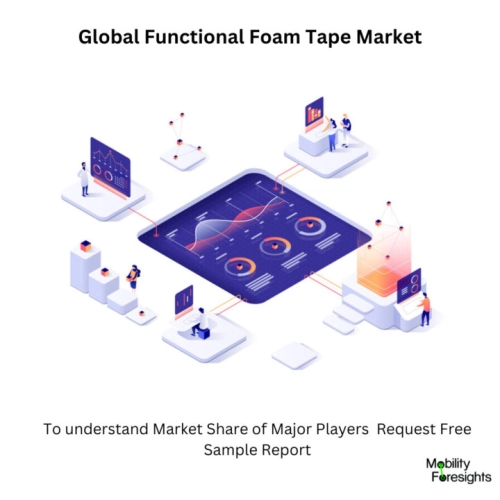
- Get in Touch with Us

Last Updated: Apr 25, 2025 | Study Period: 2024-2030
The functional foam tape is a type of double-faced tape that uses a particular polyethylene foam with an independent cell structure as the substrate.
In comparison to nonwoven fabric, it is extremely thin and soft, has great impact absorption, and is waterproof and dustproof.
Foam tapes are made to improve the aesthetic and general performance of the product design and are excellent for sealing, cushioning, gasketing, and sound absorption.
Usually, polyethylene (polyfoam) or polyvinyl chloride (PVC) make up foam tape. Foam tape produced from different materials, nevertheless, might work better for some uses.
Open cell and closed cell foam structures can be used to create different foam tape configurations. Foam tape is quite effective at insulating and works well for a variety of applications.
Foam tape has excellent insulating characteristics and works well with materials like EPDM and PVC. The following are a few advantages of foam tapes: sealing the air.
Foam tape is resistant to moisture, chemicals, ultraviolet light from the sun, and has a high adhesive strength for expansions at different temperatures.

The Global functional foam tape market accounted for $XX Billion in 2023 and is anticipated to reach $XX Billion by 2030, registering a CAGR of XX% from 2024 to 2030.
A fresh approach to connecting components commonly used in the electronics and automotive industries has been created by Schreiner Pro Tech, a German company that develops and manufactures innovative functional labels.
This patent-pending conjoining technique, sometimes known as "Fame tape," offers a quicker and more reliable substitute for traditional conjoining techniques including liquid glue, bolting, soldering, riveting, single strips of foam tape, or even frames made from full-surface cuts.
Commonly employed for this purpose are practical frames made from full-surface cuts, but they can generate a lot of waste.
The material is often only offered in single units or sheets, necessitating the use of pricey automated devices that can place and process each unit one at a time.
Additionally, the chance of improper adhesive bonding is a concern with hand processing.
| Sl no | Topic |
| 1 | Market Segmentation |
| 2 | Scope of the report |
| 3 | Abbreviations |
| 4 | Research Methodology |
| 5 | Executive Summary |
| 6 | Introduction |
| 7 | Insights from Industry stakeholders |
| 8 | Cost breakdown of Product by sub-components and average profit margin |
| 9 | Disruptive innovation in the Industry |
| 10 | Technology trends in the Industry |
| 11 | Consumer trends in the industry |
| 12 | Recent Production Milestones |
| 13 | Component Manufacturing in US, EU and China |
| 14 | COVID-19 impact on overall market |
| 15 | COVID-19 impact on Production of components |
| 16 | COVID-19 impact on Point of sale |
| 17 | Market Segmentation, Dynamics and Forecast by Geography, 2024-2030 |
| 18 | Market Segmentation, Dynamics and Forecast by Product Type, 2024-2030 |
| 19 | Market Segmentation, Dynamics and Forecast by Application, 2024-2030 |
| 20 | Market Segmentation, Dynamics and Forecast by End use, 2024-2030 |
| 21 | Product installation rate by OEM, 2023 |
| 22 | Incline/Decline in Average B-2-B selling price in past 5 years |
| 23 | Competition from substitute products |
| 24 | Gross margin and average profitability of suppliers |
| 25 | New product development in past 12 months |
| 26 | M&A in past 12 months |
| 27 | Growth strategy of leading players |
| 28 | Market share of vendors, 2023 |
| 29 | Company Profiles |
| 30 | Unmet needs and opportunity for new suppliers |
| 31 | Conclusion |
| 32 | Appendix |